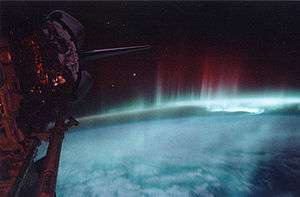Sleep in space

Sleeping in space requires that travelers sleep in a crew cabin, a small room about the size of a shower stall. They lie in a sleeping bag which is strapped to the wall.[1] Astronauts have reported having nightmares, dreams, and snoring while sleeping in space.[2]
Sleeping and crew accommodations need to be well ventilated; otherwise, astronauts can wake up oxygen-deprived and gasping for air, because a bubble of their own exhaled carbon dioxide had formed around their heads.[3] Brain cells are extremely sensitive to a lack of oxygen and brain cells can start dying less than 5 minutes after their oxygen supply disappears; the result is that brain hypoxia can rapidly cause severe brain damage or even death.[4] A decrease of oxygen to the brain can can cause dementia and brain damage, as well as a host of other symptoms.[5]
In the early 21st century, crew on the ISS were said to average about six hours of sleep per day.[6]
See also
References
- ↑ "A Day in the Life Aboard the International Space Station". NASA.
- ↑ NASA - Sleeping in Space
- ↑ "Daily life". ESA. 19 July 2004. Retrieved 28 October 2009.
- ↑ Cerebral hypoxia
- ↑ Dementia From Oxygen Deprivation
- ↑ Astronaut set to make history for longest stay in space
Sources
- http://www.asc-csa.gc.ca/eng/astronauts/living-sleeping.asp
- http://science.howstuffworks.com/sleep-in-space.htm
- http://www.theatlantic.com/technology/archive/2013/02/what-its-like-for-astronauts-to-sleep-in-space/273146/
- http://lsda.jsc.nasa.gov/scripts/experiment/exper.aspx?exp_index=848
- http://spaceflight.nasa.gov/history/shuttle-mir/science/hls/neuro/sc-hls-sleep.htm
External links
- NASA - Sleeping in Space
- The Atlantic - What It's Like for Astronauts to Sleep in Space - February 2013
